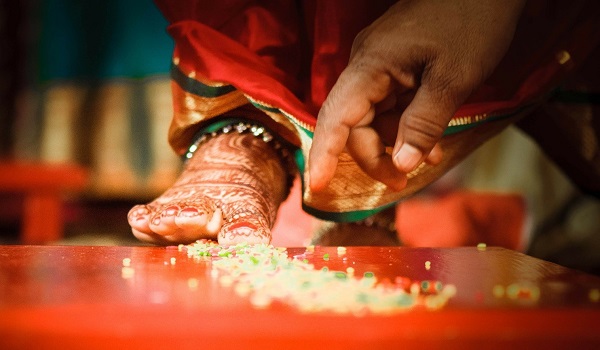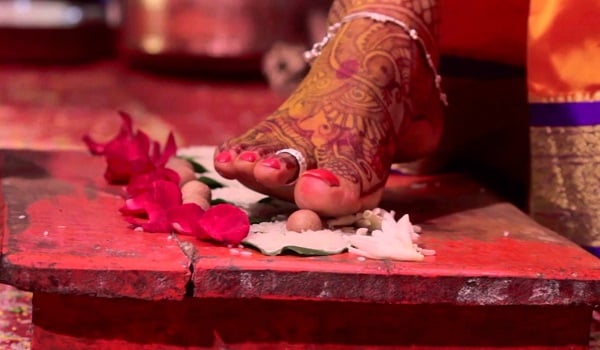
Image Source: weddingmagazine.in
Maharashtrian marriage is perhaps the most plain sailing and the least grandiose in the whole country. There are no unnecessary pre-wedding events that have no spiritual significance and the wedding rituals exhibit the core values of the Maharashtrian culture. Yet it is not to be mistaken as this drab and formal affair. Marathi weddings are full of colors and fun rituals that are sure to spice the whole event.
Matchmaking and Horoscope
The first step of a traditional Maharashtrian marriage procedure starts with Lagnaach Bedior finding a suitable match. Once that is accomplished, the horoscopes or patrikas of the boy and the girl are matched by the family priests. After the horoscopes match, the various processes leading up to the wedding begins.

Image Source: Pinterest.com
Pre Wedding Rituals
Sakhar Puda– Sakhar Puda is one of the first rituals heralding the beginning of the wedding process. It is sort of the formal engagement ceremony. It is generally held a few days before the wedding. The two families gather and the bride is given a saree, jewelry and a packet of sugar or Sakhar Puda by the groom’s mother as a sign of her acceptance to the family.
Muhurt Karane– The precise date and time of the wedding is decided by the family priest and the wedding preparations start at both houses by the inviting five married women or ‘Suhasanie’ to participate on a pre-determined auspicious day certain months before the wedding. In an iron pestle tied with mango leaves, the women pound turmeric or halkund to be used later. They roll out papads and make sandage (pulses soaked and ground, mixed with spices and dried in the sun). After this rituals the shopping starts and the bride’s side often hold a rukhvat – exhibition of decorative and food items made by the bride.
Wedding Invitations– The wedding invitations are selected and printed for both sides generally months or weeks before the designated wedding date. The first wedding invitation is always presented to Lord Ganesha as a symbolic request for him to grace the auspicious day with his divine presence.
Kelvan– A couple of days before the wedding, a puja is offered to the family deity by both the bride and groom’s side with their respective relatives and friends in attendance. This is known as the Kelvan and is generally followed by a meal.
Halad Chadavane– This particular ceremony takes place on the day before the wedding. The turmeric pound during the Muhurt Karane ritual is used by the same five Suhasinis. They apply the turmeric paste on the head, shoulders, hands and feet of the bride as well as the groom with mango leaves. The ceremony takes place in the groom’s place first, and then the leftover turmeric paste is sent to the bride’s place where it is applied on her.
Wedding Attires
The Maharashtrian groom traditionally wears an understated white or beige cotton kurta paired with a white Kanche or Dhoti with a thin border for the wedding. They take a decorative piece of cloth on their shoulders generally red or gold in color. They may wear a turban known as pheta on their head or wear the traditional white Gandhi style cap.
The bride wears silk saree with elaborate gold borders in bright colors in typical Maharashtrian trouser like style. The preferred color combinations are yellow or marigold with green or purple borders. The saree can either be Paithani measuring around 6 yards or they can be very Traditional Nauvarisarees measuring 9 yards. The Maharshtrian bride wears some typical jewelry elements – like green glass bangles or Choodas, mangalsutras with two hollow gold cups at the centers, Thusi or traditional necklaces, the typical Maharshtriannath and Vaaki or armlets. The typically Maharshtrian moon-shaped bindi is placed on her forhead.
Both the bride and the groom wear a unisex headband known as ‘Mundavalya’. It is generally two strings of pearls tied horizontally across the forehead and two lines of pears hang down from the headband in front of the ears.

Wedding Rituals
Ganpati Puja– The wedding day begins with worshipping Lord Ganesha and asking for his blessing for the couple’s future and that their lives are devoid of any obstacle.
Punyahvachan – The bride’s parents then accompany their daughter to ask everyone present at the venue to bless their daughter.
Devdevak – The family deity or Kul Devata is then invoked at the site where the wedding is to take place
The Seeman Puja – The groom and his family arrives at the wedding venue and the bride’s mother washes the groom’s feet, applies tilak on his forhead, does his arti and feeds him with sweets.
Gurihar Puja – The bride is decked up in traditional wedding attire, usually gifted to her by the maternal uncle, and she offers her worship to a silver idol of Goddess Parvati placed on a mound of rice. She offers some of the rice to the Goddess and asks for her blessing for a prosperous life.
The Antarpat ritual– The groom now appears at the mandap with his head covered by a traditional cap or turban; he wears the mundavalya and sits at his designated place on the mandap. A cloth is held in front of the groom preventing him to see the bride and this cloth is known as the Antarpat.
The Sankalp ritual - The priest chants the Mangalashtakas, or holy wedding vows. The bride is led to the mandap by her maternal uncle. The Antarpat is removed and the couple sees each other. They exchange the garlands and are showered with akshatas or unbroken rice
The Kanyadan ritual–The father of the bride then gives his daughter away to the groom along with his blessings for them to start a life of Dharma, Artha and Kama. The groom accepts his blessings and says he is receiving love in exchange of love, and that the bride is the Divine love that is showered from the Sky and received on Earth. The bride asks him to promise that he will love and respect her. The bride’s parents perform worship of the couple as avatars of Lord Vishnu and Goddess Lakshmi. The couple ties a piece of turmeric or halkund with a thread on each other’s hands and the ritual is known as Kankan bandhane. The groom then seals the ritual by placing the mangalsutra around her neck and applying vermillion on her center parting. The bride in return applies a sandalwood tilak on the groom’s forehead.
The Satapadhi ritual– The couple circumambulate around the sacred fire seven times saying out loud the seven ritualistic weddings vows.
The Karmasampati ritual– At the end of all wedding ritual the couple prays in front to the holy fire before it is extinguished. The father of the bride playfully twists the groom’s ear to remind him of his future duties. The couple gets up from the mandap and seeks blessings from all relatives present.
Post Wedding Rituals
The Varat ritual– After completion of the wedding rituals, the bride bids tearful goodbye to her family and is led to her husband’s home. The groom picks up the silver idol of Devi Parvati during the Gaurihar Puja. The Varat refers to the procession that sees the bride off from her paternal home to her husband’s home.
The Grihapravesh– Grihapravesh is the first ritual conducted after wedding. The groom's mother embraces the new couple and washes their feet with milk and water. After this the traditional aarti is performed and the bride is asked to enter the house by knocking down a glass of rice, kept at the entrance. The couple enters the house with their right foot.
The Reception–Last but not the least Reception party is organized, wherein the newly married couple meets and greets all family and friends, while sumptuous food is served for the guests. The bride wears saree and Jewelry gifted to her from the groom’s side while the groom dresses in attires presented by the bride’s side.




